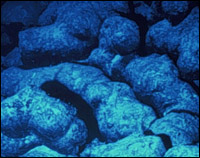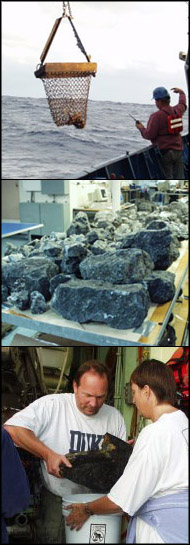
Pieces of the seafloor
Fig. 4. Scientists huddled around Alvin's collection baskets.
Still, both dives returned with plenty of rock samples, which drew exuberant scientists to the collection baskets as soon as Alvin returned. They clustered there like children around an ice cream truck, fighting the urge to touch the rocks before they had been properly processed for removal. Fortunately for the mission, scientific discipline won out.
After Hurst's and Gee's aborted trip to the massif's dome on Thanksgiving, and Hanna's and Lyons' rapid touch-and-go hours later, John and Sasagawa returned to the mountaintop on Nov. 24 to gather samples and make gravity measurements with the Scripps gravimeter. John said some of the rocks had an "orange peel or elephant skin appearance." Sasagawa reported making six gravity measurements, and lots of problems keeping the top-heavy gravimeter from falling over on the uneven terrain. Where it did work, pilot and Alvin expedition leader Pat Hickey did "an amazing little dance" with both manipulating arms to keep the instrument upright, John reported admiringly.
On Nov. 25 Hurst returned to the dome, where he, too, reported problems with the gravimeter's topheaviness, spending 1½ hours making just one measurement. Alvin's manipulators also were unable to tear away some rock samples. Later in the dive, Alvin crossed what is "almost certainly a fault," Hurst said. Then they starting moving up a scarp where they encountered pillow-shaped deposits of now-frozen lava, evidence of former volcanism.

Fig. 5. Pillow lavas from the MARK area of Mid-Atlantic Ridge.
Cann and Nooner descended to the top of the hanging wall on Nov. 26. During the science meeting, Nooner reported three successful gravity measurements, though the instrument "fell over several times," he said. "As we went across the top we saw outcrops of pillow lava," Cann added. "Occasionally there might have been very small faults."
That night, Hickey warned waves were 25 feet high with winds blowing over 30 knots, feedback from a strong storm system far to the northwest. Next morning, the seas were still too high to launch Alvin, so Blackman decided to try pulling up rock samples by dragging the slopes with a towed dredge.

Dredging
Fig. 6. (a) Dredge being lowered over the side of Atlantis. (b) A bounty of rocks from the dredge. Most of them are peridotites. (c) Scientists sorting the heavy catch.
Dredges are "one of the oldest oceanographic tools known, outside of a bucket," Bosun Bailey said after lunch as he prepared to lower an example from an upper deck. Basically a chain basket suspended from a heavy frame with a weight inside, it's "a very brutal basic tool" that can occasionally reap great dividends, he added.
Dredging is something like fishing. Once Bailey had it craned to the fantail, the dredge was attached to a meter that would allow the scientists to monitor the strain on its tow cable. A big strain would mean that the dredge might have caught some rocks, or at least was briefly snagged on an obstacle that got away. The only way scientists would know which was which was to pull the dredge back up and see.
Blackman assigned the scientists to one of a series of round-the-clock dredge watches. Those standing watch might begin their assigned hours in a hardhat helping the deck crew lower the device into the water. The action would then move into Atlantis' computer room, where they would look for sharp jagged "spikes" in the normally wavy lines moving across the video screen monitoring the cable's tension. In fishing terms, sharp spikes could mean a nibble, or a bite.
Initial efforts seemed unpromising. But, around midnight, dredge number 3 arrived on deck from the massif's eastern wall with enough rocks to cover a long table in the main lab and spill over to rooms where specimens are being sorted, archived and cut up.

Meanwhile, with the seas subsiding Karson and Gee have descended to the south wall aboard the latest Alvin dive. The quest goes on.
Fig. 7. Thin-section image of serpentinized peridotite collected during ODP Leg 153 from the MARK area of the Mid_Atlantic Ridge. It is cut by a later serpentine vein. The photo is taken under crossed polars and is 45 X 27 mm.
Join us next Tuesday for the next report...
Today's pages:
Alvin: History and Launch | Alvin Recovery | Under the Sea | Dredging

|
|
|









